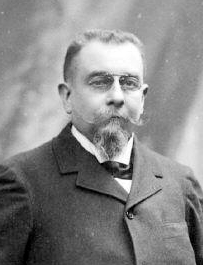Albert Lavignac
Albert Lavignac | |
|---|---|
 | |
| Born | 21 January 1846 Paris |
| Died | 28 May 1916 (aged 70) Paris |
| Occupation(s) | Musicologist Composer |
Alexandre Jean Albert Lavignac (21 January 1846 – 28 May 1916) was a French music scholar, known for his essays on theory, and a minor composer.
Biography
[edit]Lavignac was born in Paris and studied with Antoine François Marmontel, François Benoist and Ambroise Thomas at the Conservatoire de Paris, where later he taught harmony. Among his pupils were Henri Casadesus, Claude Debussy, Vincent d'Indy, Amédée Gastoué, Philipp Jarnach, Henri O'Kelly, Gabriel Pierné, Wadia Sabra, Florent Schmitt. See: List of music students by teacher: K to M#Albert Lavignac.
In March 1864, at the age of eighteen, he conducted from the harmonium the private premiere of Gioachino Rossini's Petite messe solennelle.
His condensed work, La Musique et les Musiciens, an overview of musical grammar and materials, continued to be reprinted years after his death. In it he characterised the particular characteristics of instruments[1] and of each key,[2] somewhat in the way Berlioz and Gevaert (Traité d'orchestration, Gand, 1863, p. 189) had done:
Major keys:
- C-sharp major: ? ("?")
- F-sharp major: Rough ("rude")
- B major: Energetic ("énergique")
- E major: Radiant, warm, joyous ("éclatant, chaud, joyeux")
- A major: Frank, sonorous ("franc, sonore")
- D major: Joyful, brilliant, alert ("gai, brilland, alerte")
- G major: Rural, merry ("champêtre, gai")
- C major: Simple, naive, commonplace ("simple, naïf, franc, ou plat et commun")
- F major: Pastoral, rustic ("pastoral, agreste")
- B-flat major: Noble and elegant, graceful ("noble et élégant, gracieux")
- E-flat major: Vigorous, chivalrous ("sonore, énergique, chevaleresque")
- A-flat major: Gentle, caressing, or pompous ("doux, caressant, ou pompeux")
- D-flat major: Charming, suave, placid ("plein de charme, placide, suave")
- G-flat major: Gentle and calm ("doux et calme")
- C-flat major: ? ("?")
Minor keys:
- A-sharp minor: ? ("?")
- D-sharp minor: ? ("?")
- G-sharp minor: Very somber ("très sombre")
- C-sharp minor: Brutal, sinister, or very sombre ("brutal, sinistre ou très sombre")
- F-sharp minor: Rough, or light, aerial ("rude ou léger, aérien")
- B minor: Savage or sombre but vigorous ("sauvage ou sombre, mais énergique")
- E minor: Sad, agitated ("triste, agité")
- A minor: Simple, naive, sad, rustic ("simple, naïf, triste, rustique")
- D minor: Serious, concentrated ("sérieux, concentré")
- G minor: Melancholy, shy ("mélancolique, ombrageux")
- C minor: Gloomy, dramatic, violent ("sombre, dramatique, violent")
- F minor: Morose, surly, or energetic ("morose, chagrin, ou énergique")
- B-flat minor: Funeral or mysterious ("funèbre ou mystérieux")
- E-flat minor: Profoundly sad ("profondément triste")
- A-flat minor: Lugubrious, anguished ("lugubre, angoissé")
His more popularized works discussed the music dramas of Richard Wagner, summarised in Le Voyage artistique à Bayreuth.
Selected works
[edit]Lavignac edited the compendious Encyclopédie de la Musique.
- Cours complet théoretique et pratique de dictée musicale (1882)
- École de la pédale (1889)
- La musique et les musiciens (1895). Translated into English, 1905
- Le voyage artistique à Bayreuth (1897). An analysis of Wagner's leitmotifs
- The Music Dramas of Richard Wagner and His Festival Theater in Bayreuth (New York, 1899)
Footnotes
[edit]- ^ "The timbre of the trombone is in its nature majestic and imposing. It is sufficiently powerful to dominate a whole orchestra and produces an impression of superhuman power ... it can become terrible ... or mournful and full of dismay: or it may have the serenity of the organ ... It is a superb instrument of lofty dramatic power, which should be reserved for great occasions."
- ^ page 424
References
[edit]External links
[edit]- Free scores by Albert Lavignac at the International Music Score Library Project (IMSLP)
- Public domain scan of Music and Musicians.
| International | |
|---|---|
| National | |
| Academics | |
| Artists | |
| People | |
| Other | |
Text is available under the CC BY-SA 4.0 license; additional terms may apply.
Images, videos and audio are available under their respective licenses.
